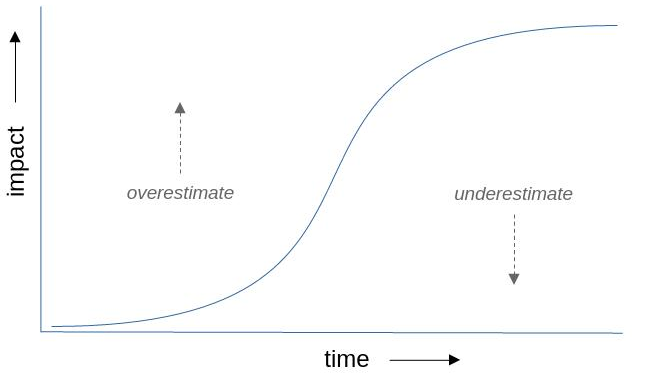Amara's Law
We tend to overestimate the effect of a technology in the short run and underestimate the effect in the long run. - attributed to Roy Amara
There is a range of commentary when a new technology emerges and these tend to fall into two camps. One, is an over-estimation bias on the new technology’s impact on…well…just about everything. This over-estimation usually is in the form of either a fear-based narrative or an utopian-based narrative. An example of a fear-based narrative is Generative AI, and a belief that it will wipe out journalism, destroy academic learning, and lead us to a dystopic future. Even Sora, despite the deepfake and disinformation angle, could be of great value for society (just have to wait and let it develop). An example of an utopian-based narrative is that of autonomous vehicles and how we will soon find ourselves in a uber-esque car sharing economy of precision and efficiency. Yet, radar cruise control or Tesla’s Autopilot is a considerably long way off from KITT.
The second, is an under-estimation bias on the new technology’s impact often expressed in how the new technology is over-hyped and under-delivers and soon to go the way of HD DVD. A good example, is non-fungible tokens (NFTs) and a hyper-focus on the lack of utility that cartoon apes have for our economy and society. This fails to account for the long-term potential of the underlying technology that NFTs could provide. One small example, currently you can sell your physical collection of LPs - imagine if you could do the same (or trade or rent) your digital collections (or all those Fortnite skins), the transaction could also carry back a small royalty to the original content creator - this is a potential use case for NFT technology.
Both of these biases likely occur due to anchoring effect where we consider a particular value for an unknown quantity before making an estimation (Kahneman, 2011, 119). More specifically, anchoring as a priming effect, selecting compatible evidence as an anchor to suggest a value for the unknown quantity (Kahneman, 122). For example, automation has negatively changed the human manpower landscape in manufacturing. The association of this value (data point) with Generative AI (seen as a form of automation) anchors the disruption value to a negative impact (jobloss). Likely things like cartoon apes are being anchored against similar fads like pet rocks, but this misses the underlying technology powering the hype. A good example of this is the use of QR codes in advertising and how this was hyped as the game changer for interactive marketing; however, this missed the underlying technology of QR codes that are now ubiquitous in everything from restaurant menus, mobile payments, event tickets or boarding passes.
 Amara’s Law
Amara’s Law
Both of these forms of commentary fail to account for Amara’s Law. Best to keep this in mind when judging (pre-maturely) other emerging technologies. To help, here are some technologies that follow(ed) Amara’s Law (I generated this list using a new technology, large language models (LLMs), a subset of Generative AI (OpenAI, 2024):
- Personal Computers - from niche applications to exponential productivity and bedrock of WFH
- 3D Printing - from hobbyist to industrial application
- Social Media - from college lookbooks to influencer of geopolitical events (coups, elections, et cetera)
- VR/AR - the jury is still out on this one, but I think this falls in the same camp as NFTs - unmet high expectations in the short term leading to discounting the future disruption
- E-Commerce - from sock puppets to default commerce method
Lastly, the Internet - obscure network for spooks and academics to essential universal utility for the entire planet. So we should all keep this in mind when being quick to gravitate toward over or under estimating the impact of new technology.
“What is the Internet?” The Today Show, 1994
__________
Kahneman, Daniel. 2011. Thinking, Fast and Slow. New York: FSG Books.
OpenAI. 2024. “Conversation on Amara’s Law.” ChatGPT-4.0, January 29.
Ratcliffe, Susan, ed. 2016. “Roy Amara 1925–2007, American futurologist”. Oxford Essential Quotations, Vol. 1 (4th ed.). Oxford University Press. doi:10.1093/acref/9780191826719.001.0001
__________
© 2024 Jeremy Reynolds, all rights reserved.
Back to Blog Index
innovation